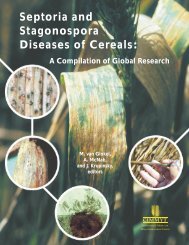Section 3 (Crop Management)
Section 3 (Crop Management)
Section 3 (Crop Management)
You also want an ePaper? Increase the reach of your titles
YUMPU automatically turns print PDFs into web optimized ePapers that Google loves.
Proceedings of the 8 th Asian Regional Maize Workshop, Bangkok, Thailand: August 5-8, 2002<br />
Maize in the Rice-Wheat Rotation of Indo-Gangetic Plains<br />
Raj K Gupta, Gonzalez-Ceniceros Fernando, Sarvesh Paliwal,<br />
SVRK, Prabhakar and Ashish Srivastava<br />
CIMMYT-India Office, CG Block, NASC Complex, DPS Marg, New Delhi, India.<br />
e-mail: r.gupta@cgiar.org<br />
Abstract<br />
The rice-wheat rotation is the most important cropping system in south Asia because of its role in<br />
food security as consumers here prefer wheat ‘chapati’ and rice. Overexploitation of groundwater and<br />
other natural resources resulted in either stagnation or decline in total factor productivity in this rotation<br />
and calls for a systems approach to revive agriculture in this region. There is a need to diversify ricewheat<br />
rotation and opportunities exist to do so. Keeping in view the nutritional and income security of the<br />
population in South Asian countries, this paper discusses how tillage and crop establishment can provide<br />
options to the farmers for diversification of rice-wheat rotation through incorporation of maize. Some of<br />
the options include growing maize in zero-till and raised bed systems, and introducing maize as an<br />
intercrop in the existing preferred crops. The alternative tillage and crop establishment practices help<br />
reduce some of the problems identified by improving maize productivity in the region such as late<br />
planting while improving the resource use efficiency.<br />
Introduction<br />
The rice-wheat rotation is the backbone for food security of South Asian countries comprising<br />
Pakistan, India, Nepal, and Bangladesh. These crops are being cultivated in 13.5 mha of fertile lands<br />
blessed with dependable irrigation facilities developed over the years (Gupta et al., 2002). These areas<br />
were also the beneficiary of Green Revolution in food grain production owing to the bounty of natural<br />
resources they enjoyed. However, of late, because of the over exploitation and injudicious use of chemical<br />
fertilizers and irrigation facilities created, the productive soils have gradually started showing the signs of<br />
fatigue such as significant decline in soil organic carbon content, development of micronutrient<br />
deficiencies in recurrence, increased soil salinity, stagnation of growth in crop productivity in some places<br />
with the signs of declining productivity (Ladha et al., 2003), requiring an approach hitherto unknown in<br />
the post Green Revolution agrarian history of these countries. In 1994, The Rice-Wheat Consortium for<br />
the Indo-Gangetic Plains, comprising of national agricultural research systems of Pakistan, India, Nepal,<br />
and Bangladesh; international centers representing CGIAR (CIMMYT, CIP, ICRISAT, IRRI and IWMI);<br />
NGOs, private entrepreneurs, and farmer groups, was formed as an ecoregional program of the CGIAR<br />
with ICRISAT as lead center which later on was transferred to CIMMYT. The Consortium has been<br />
evolving various concepts and technologies having potential to revive the declining trends observed in its<br />
countries. Some of these technologies are zero tillage, bed planting, and integrated input management for<br />
water, nutrients and judicious use of chemical inputs, while giving thrust on crop diversification as an<br />
option for better nutritional and income security. Many of these technologies are centered on the basic<br />
natural resource management methods such as zero tillage and bed planting systems.<br />
Diversification of Rice-Wheat Rotation<br />
While above mentioned problems in rice-wheat rotation reflect on one hand the deteriorating quality<br />
of natural resource base, it also reflects, on the other hand, the nutritional and income security of<br />
- 205 -









